
This article explains how German Equatorial Mounts work.
Most people are familiar with camera tripods that offer vertical movement and head rotation. Telescope mounts based on this principle are called Altitude-Azimuth mounts, or Alt-Az mounts for short. German Equatorial Mounts (GEMs) are more complex, but they are preferred by astrophotographers and observers who like to view particular objects for long periods. Furthermore, GEMs are ideal for finding faint celestial objects just by coordinates.
But most of the time, Equatorial Mounts are not recommended for beginner astronomers, regardless of quality. They tend to be more expensive than an altaz of the same quality, are more sensitive to balance, but most importantly they have a complex set up procedure and mode of operation. Most beginners have a poor understanding of the motions of the night sky, how the sky rotates around the celestial poles, and that’s okay. A beginner astronomer will pick that up as they learn, but it means that an equatorial mount can be confusing and frustrating to use at first.
And it’d be one thing if equatorial mounts supplied with beginner telescopes were actually good. Unfortunately, this isn’t usually the case. While the actual equatorial mounts are usually not bad, they’re almost invariably paired with overweight telescopes, especially in the case of Celestron’s PowerSeeker and AstroMaster series of telescopes. If you’re buying an equatorial telescope, look up the mount separately, find its maximum payload, and make sure the weight of the optical tube of the telescope is not more than that.
German Equatorial Mounts are designed to compensate for the earth’s rotation. The earth rotates, and so do observers who are standing on it. This gives the appearance as if stars circle in the sky. If observed with bare eyes, stars move very slowly (one revolution in 24h), but the telescope magnification increases this speed proportionally. A telescope with a power of 100, let stars “move” 100 times faster. If an observer uses for example an eyepiece with an apparent FOV of 50 deg, and a telescope with a magnification of 100, it takes only about 2 minutes for a star to wander from one side of the eyepiece to the opposite side.
German Equatorial Mounts use slow motion knobs or slow-motion cables to manually to keep the object in view. This can be a blessing if it works right, but if the mount is overburdened and/or out of balance, the slow motions might not work at all. Many EQ mounts have motor drive accessory packs, which allow you to convert the telescope for automatic tracking. Some German Equatorial Mounts are motorized to begin with, but very few of those are available as entry-level telescopes.
These mounts also come with setting circles, which in the vast majority of beginner telescopes is just sciencey decoration rather than a genuinely useful method for locating objects in the sky.
- EQ-1: Sold by Celestron as the CG-2 and CG-3, the EQ-1 is one of the smallest equatorial mounts available. If paired with a suitably small telescope of no more than 7 lbs, and if paired with a suitably sturdy tripod, it can perform fairly well. But Celestron pairs this mount with telescopes of 9 lbs or more.
- EQ-2: Orion and other manufacturers have the good sense to put heavier telescopes on mounts which can at least theoretically support them. The EQ-2 is a little beefier than the EQ-1 and can support telescopes up to 9 lbs, but is still paired with overweight telescopes. My experience with both the EQ-1 and EQ-2 telescopes was that they were very wobbly.
- Higher-end models like the CG-4 can be a joy to use, but you won’t find them on beginner telescopes, only intermediate-level telescopes.
Theoretically, if the mount is properly aligned and the motor is running (or the slow-motion knob is turned), an object will stay in the field of view (FOV) as long as the observer desires.
Polar Alignment of German Equatorial Mounts
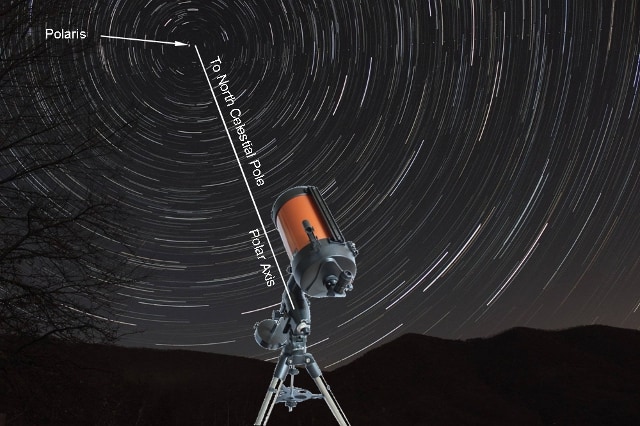
Exact compensation for the earth’s rotation is only possible if both, the polar axis of the mount and the polar axis of the earth are in perfect alignment. Other than Alt-Azimuth mounts, which offer only 2 axes of movement, German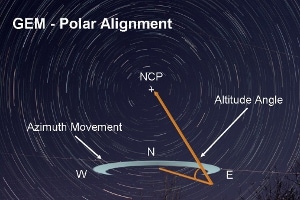
Polar Scope
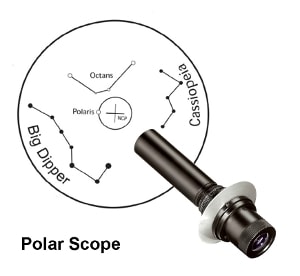
Once the German Equatorial Mount has been properly aligned, latitude and azimuth screws are secured; they should not be touched during the remaining observing session. At first glance it seems rather strange that these axes are secured and left alone; are these not exactly the degrees of movements that are used with Alt-Az mounts to point at the objects we want to see? Yes – however GEMs offer two more degrees of movement to set Declination and Right Ascension, or DEC and R.A. for short.
Declination
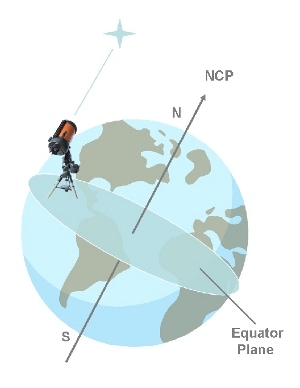
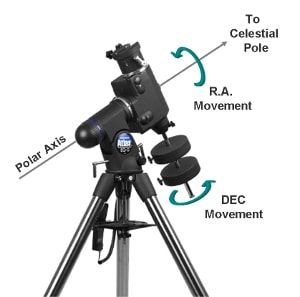
It may be a bit confusing for beginners to imagine the celestial equator and the related Declination. A really simple way to picture this is to replace the sphere of the earth with a flat, circular platform on which the telescope stands. The platform has the size of the earth’s equator and the axis is the polar axis. Even when moving the telescope to any place on this disc, the Declination of the object will be always the same. The famous Andromeda Galaxy (M31) can for example always be found at DEC 41° 16’, this is independent if we observe it from New York, Los Angeles, or Munich.
Right Ascension
The last degree of movement at a GEM is called Right Ascension (R.A.). After proper alignment, the R.A. axis points exactly at the NCP / SCP, and with that, any R.A. rotation describes a circle as do the stars in the sky. Motors (or hand controls) can follow the apparent movement of a celestial object perfectly. Right Ascension is commonly used in units of time (hours, minutes, and seconds).
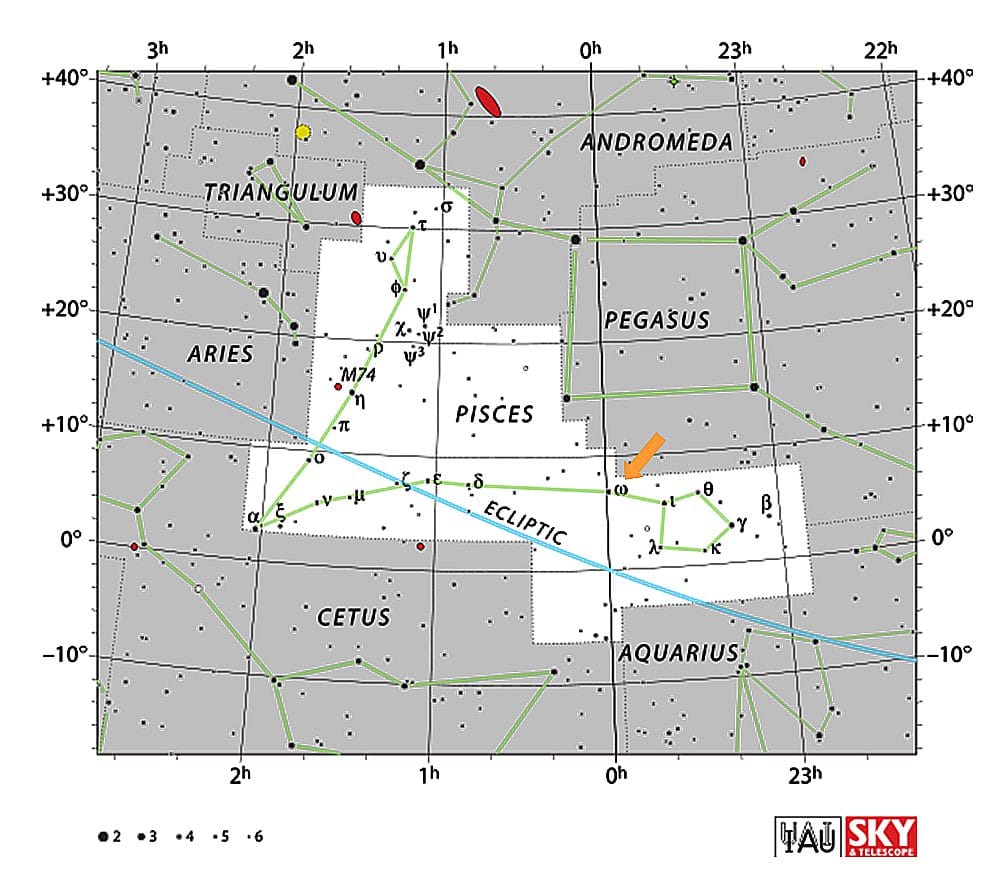
Greenwich has been arbitrarily selected as the start point for the earth’s longitude scale (0°), similarly, the celestial zero-point for Right Ascension (00h 00min 00sec) has been chosen arbitrarily to be the vernal equinox. A useful reference for astronomers is located in the constellation Pisces. With R.A. of 23h 59m 19s, the star Omega Pisces is currently very close to the zero point. Right Ascension of all other objects is designated by how long they lag behind this coordinate after it passes overhead moving toward the west.
Setting Circles
German Equatorial Mounts are equipped with setting circles for R.A. and DEC and slow-motion controls (or motors) that move the telescope in these directions. Setting circles are scaled discs attached to the R.A. and DEC axes.
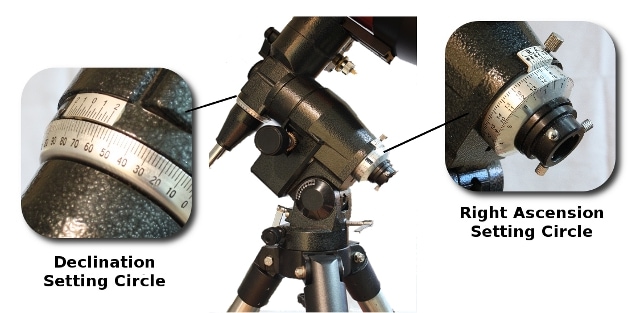
They are marked with a 90 – 0 – 90 degree scale for DEC and a 0h to 24h scale for R.A. Setting circles are ideal to point the telescope at a particular object just by setting its coordinates. Most GEMs have movable setting circles. Their use is quite easy; astronomers point the telescope to a star with known R.A. and DEC coordinates close to the wanted object. They adjust the setting circles to the exact coordinates of the known star and move the telescope until the scales show exactly the wanted coordinates. It is surprising how easy it is to find faint objects with this method.
Balancing the German EQ Mount
All German Equatorial Mounts need one or more counterweights to balance the telescope. The position of counterweights is variable for balancing any load. Balancing is of utmost importance because it minimizes the burden on the gear and bearings. Clutches that hold the telescope in place are also much less stressed with a balanced setup. Conversely, a highly unbalanced set-up will most certainly damage the gearbox (and probably the motor). Furthermore, it is much more convenient to work with a balanced telescope that stays put when released instead of shifting and slipping at its own.
It is often forgotten that the focuser is extracted when the telescope is in use. Due to the weight of diagonal, eyepiece, and sometimes even a camera, this extraction shifts the center of gravity significantly. This has to be considered during the balancing procedure.
Load Capacity
Most manufacturers are quite “generous” when describing the load capacity of their GEMs. Specifications should be taken with care, particularly for entry-level mounts. Load capacity includes, with the exception of the balance weights, everything that is put on the mount: telescope, finder scope, diagonal, eyepiece, accessories, additional mounting hardware, and when shooting astrophotography, camera and addition accessories.
Do not overload the mount, it will make it unstable and results in unwanted mount wiggling and mount shake. This effect is multiplied by the magnification power of the telescope. Weak, wiggly mounts can make observing indeed quite unpleasant. Stable solid mounts are absolutely paramount for any kind of astrophotography. Astrophotographers tend to load their mounts only with 50% of the actual load capacity for the best stability. There is much truth in the astrophotographers proverb:
“A good mount with a mediocre telescope will provide much better images than a good telescope on a weak mount.”
How does Motorized German EQ Mount Works
Motorized GEMs come with one or two motors to control either only R.A. or both, R.A. and DEC. Most manual mounts can be retrofitted with small motors. For stargazing it is often more convenient to have only a R.A. motor drive and correct possible DEC deviations manually.
Completely different types are computerized GoTo mounts. These mounts have not only coordinates of thousands of celestial objects stored in their memory; they have also electronic versions of setting circles built in; they are called rotary sensors. A computer calculates the position, counts the necessary sensor impulses, and drives the motors to the right point. Before the computer can find any object, it needs calibration on reference points, which are usually three known stars (three-star-alignment). Some stargazers conclude falsely that this alignment substitutes for proper polar alignment of the mount – this is not the case. After a successful three-star-alignment, the computer can point the telescope automatically at any wanted celestial object.
